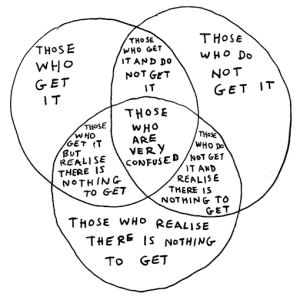Leadership is not always glamourous!
It can be hard getting people (or penguins) to play follow the leader without having trust!
Sometimes the leader is the first one to get killed leading the team or army into battle.
Peter Drucker famously stated that “management is doing things right; leadership is doing the right things.”
Great leaders possess dazzling social intelligence, a zest for change, and above all, vision that allows them to set their sights on the “things” that truly merit attention. Not a bad skill set for the rest of us, either.
Leadership has been described as “a process of social influence in which one person can enlist the aid and support of others in the accomplishment of a common task,”although there are alternative definitions of leadership. For example, some understand a leader simply as somebody whom people follow, or as somebody who guides or directs others, while others define leadership as “organizing a group of people to achieve a common goal.”
Studies of leadership have produced theories involving traits, situational interaction, function, behavior, power, vision and values, charisma, and intelligence, among others.
Determination and drive include traits such as initiative, energy, assertiveness, perseverance, masculinity, and sometimes dominance. People with these traits often tend to wholeheartedly pursue their goals, work long hours, are ambitious, and often are very competitive with others. Cognitive capacity includes intelligence, analytical and verbal ability, behavioral flexibility, and good judgment. Individuals with these traits are able to formulate solutions to difficult problems, work well under stress or deadlines, adapt to changing situations, and create well-thought-out plans for the future. Howell provides examples of Steve Jobs and Abraham Lincoln as encompassing the traits of determination and drive as well as possessing cognitive capacity, demonstrated by their ability to adapt to their continuously changing environments.
Self-confidence encompasses the traits of high self-esteem, assertiveness, emotional stability, and self-assurance. Individuals that are self-confident do not doubt themselves or their abilities and decisions; they also have the ability to project this self-confidence onto others, building their trust and commitment. Integrity is demonstrated in individuals who are truthful, trustworthy, principled, consistent, dependable, loyal, and not deceptive. Leaders with integrity often share these values with their followers, as this trait is mainly an ethics issue. It is often said that these leaders keep their word and are honest and open with their cohorts.
Sociability describes individuals who are friendly, extroverted, tactful, flexible, and interpersonally competent. Such a trait enables leaders to be accepted well by the public, use diplomatic measures to solve issues, as well as hold the ability to adapt their social persona to the situation at hand. According to Howell, Mother Teresa is an exceptional example that embodies integrity, assertiveness, and social abilities in her diplomatic dealings with the leaders of the world.
Few great leaders encompass all of the traits listed above, but many have the ability to apply a number of them to succeed as front-runners of their organization or situation.
A leadership style is a leader’s style of providing direction, implementing plans, and motivating people. It is the result of the philosophy, personality, and experience of the leader. Rhetoric specialists have also developed models for understanding leadership.
Different situations call for different leadership styles. In an emergency when there is little time to converge on an agreement and where a designated authority has significantly more experience or expertise than the rest of the team, an autocratic leadership style may be most effective; however, in a highly motivated and aligned team with a homogeneous level of expertise, a more democratic or laissez-faire style may be more effective. The style adopted should be the one that most effectively achieves the objectives of the group while balancing the interests of its individual members.
Engaging style
Engaging as part of leadership style has been mentioned in various literature earlier. Dr. Stephen L. Cohen, the Senior Vice President for Right Management’s Leadership Development Center of Excellence, has in his article Four Key Leadership Practices for Leading in Tough Times has mentioned Engagement as the fourth Key practice. He writes, “these initiatives do for the organization is engage both leaders and employees in understanding the existing conditions and how they can collectively assist in addressing them. Reaching out to employees during difficult times to better understand their concerns and interests by openly and honestly conveying the impact of the downturn on them and their organizations can provide a solid foundation for not only engaging them but retaining them when things do turn around.
Engagement as the key to Collaborative Leadership is also emphasized in several original research papers and programs. Becoming an agile has long been associated with Engaging leaders – rather than leadership with a hands-off approach.
Autocratic or authoritarian style
Under the autocratic leadership style, all decision-making powers are centralized in the leader, as with dictators.
Leaders do not entertain any suggestions or initiatives from subordinates. The autocratic management has been successful as it provides strong motivation to the manager. It permits quick decision-making, as only one person decides for the whole group and keeps each decision to him/herself until he/she feels it needs to be shared with the rest of the group.
Participative or democratic style
The democratic leadership style consists of the leader sharing the decision-making abilities with group members by promoting the interests of the group members and by practicing social equality. This has also been called shared leadership.
Laissez-faire or free-rein style
A person may be in a leadership position without providing leadership, leaving the group to fend for itself. Subordinates are given a free hand in deciding their own policies and methods. The subordinates are motivated to be creative and innovative.
Narcissistic leadership
Narcissistic leadership is a leadership style in which the leader is only interested in him/herself. Their priority is themselves – at the expense of their people/group members. This leader exhibits the characteristics of a narcissist: arrogance, dominance and hostility. It is a common leadership style. The narcissism may range from anywhere between healthy and destructive. To critics, “narcissistic leadership (preferably destructive) is driven by unyielding arrogance, self-absorption, and a personal egotistic need for power and admiration.”
Toxic leadership
A toxic leader is someone who has responsibility over a group of people or an organization, and who abuses the leader–follower relationship by leaving the group or organization in a worse-off condition than when he/she joined it.
Task-oriented and relationship-oriented leadership
Task-oriented leadership is a style in which the leader is focused on the tasks that need to be performed in order to meet a certain production goal. Task-oriented leaders are generally more concerned with producing a step-by-step solution for given problem or goal, strictly making sure these deadlines are met, results and reaching target outcomes.
Relationship-oriented leadership is a contrasting style in which the leader is more focused on the relationships amongst the group and is generally more concerned with the overall well-being and satisfaction of group members. Relationship-oriented leaders emphasize communication within the group, shows trust and confidence in group members, and shows appreciation for work done.
Task-oriented leaders are typically less concerned with the idea of catering to group members, and more concerned with acquiring a certain solution to meet a production goal. For this reason, they typically are able to make sure that deadlines are met, yet their group members’ well-being may suffer. Relationship-oriented leaders are focused on developing the team and the relationships in it. The positives to having this kind of environment are that team members are more motivated and have support, however, the emphasis on relations as opposed to getting a job done might make productivity suffer.
Sex differences in leadership behavior
Another factor with leadership style is whether the person is male or female. When men and women come together in groups, they tend to adopt different leadership styles. Men generally assume an agentic leadership style. They are task-oriented, active, decision focused, independent and goal oriented. Women, on the other hand, are generally more communal when they assume a leadership position; they strive to be helpful towards others, warm in relation to others, understanding, and mindful of others’ feelings. In general, when women are asked to describe themselves to others in newly formed groups, they emphasize their open, fair, responsible, and pleasant communal qualities. They give advice, offer assurances, and manage conflicts in an attempt to maintain positive relationships among group members. Women connect more positively to group members by smiling, maintaining eye contact and respond tactfully to others’ comments. Men, conversely, describe themselves as influential, powerful and proficient at the task that needs to be done. They tend to place more focus on initiating structure within the group, setting standards and objectives, identifying roles, defining responsibilities and standard operating procedures, proposing solutions to problems, monitoring compliance with procedures, and finally, emphasizing the need for productivity and efficiency in the work that needs to be done. As leaders, men are primarily task-oriented, but women tend to be both task- and relationship-oriented. However, it is important to note that these sex differences are only tendencies, and do not manifest themselves within men and women across all groups and situations.
Find full attribution and the full article at Wikipedia: bit.ly/1aYLYSr
Maps??? Who needs maps… We’re going straight to the top!




Leave a Reply